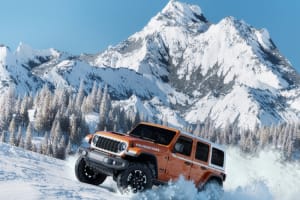Picture this: a shiny, futuristic truck that's supposed to redefine toughness, grinding to a halt on one of the roughest paths in the country. The Tesla Cybertruck, with all its hype and electric muscle, met its match on California's infamous Rubicon Trail. This wasn't just a quick hiccup—it was a multi-day ordeal that left onlookers shaking their heads and wondering if these high-tech rigs are really ready for the wild. For guys who love hitting the dirt in their pickups, this story hits home, raising real questions about what happens when cutting-edge tech meets old-school rugged terrain.
The Rubicon Trail isn't for the faint of heart. Stretching 22 miles through the Sierra Nevada mountains in Northern California, it's a brutal test track that's been challenging off-roaders for decades. Rocks, steep climbs, and narrow squeezes make it the ultimate proving ground for any vehicle claiming to be tough. Manufacturers often use it to show off their latest models, but Tesla never officially put the Cybertruck through its paces here. That didn't stop one determined owner from giving it a shot, and the results were anything but smooth.
This particular Cybertruck wasn't stock—it had been beefed up for serious off-roading. Outfitted by a company specializing in Cybertruck mods, it sported heavy-duty upgrades that screamed adventure-ready. Up front, there was a beefy bumper designed to take hits, paired with a massive 12,000-pound winch for pulling itself out of tight spots. Rock sliders ran along the sides to protect the underbody from scrapes and bashes, and the rear bumper was reinforced too. On top of that, it carried all the gear you'd expect for an overland trip: camping setups, extra supplies, and tools for the long haul. It looked like the kind of rig that could handle a weekend warrior's dreams, far from the basic model rolling off the assembly line.
But looks can be deceiving, especially on a trail like the Rubicon. The trouble started early. The truck was spotted at the staging area near Loon Lake around 9 or 10 in the morning on August 4, as groups of off-roaders geared up for their runs. It had a support vehicle tagging along—a Jeep JL Wrangler Unlimited Rubicon, loaded with recovery gear and acting as a mobile generator station. That Jeep would prove crucial, but it also highlighted the Cybertruck's vulnerabilities right from the jump.
As the group pushed forward, the Cybertruck began struggling almost immediately. Witnesses reported it getting hung up on what most experienced drivers would call mild obstacles—nothing too extreme for a properly built rig. By the time it reached Arnold's Rock, not even halfway through the trail, the crew was already digging into their spare parts. They'd brought along six tie rods, those critical components that connect the steering to the wheels, but they were down to just two. At least one steering rack had already been swapped out, a major repair that usually happens in a garage, not on a dusty trail.
Things went from bad to worse as the days dragged on. By Wednesday, the truck was limping into Rubicon Springs with its battery critically low. The crew fired up generators borrowed from the campground caretakers, but even after hours of running, they could only squeeze out about 7% charge. Somehow, they juiced it enough to keep going, but the real disaster hit on Friday around 3 p.m. at the top of Cadillac Hill, one of the trail's toughest sections. The Cybertruck took a beating—snapping more tie rods and suffering heavy damage to the front end. The bumper was mangled, and the supporting structure on the driver's side looked like it had been ripped apart. It was winched off to the side to let other vehicles pass, but there it sat, stranded and broken.
For the next several days, the truck became a spectacle for passing off-roaders. Photos popped up in local Facebook groups and on Instagram, showing the angular beast sidelined amid the rocks. One group that passed it on Saturday afternoon noted a crew working to replace the steering rack again. But here's where the Cybertruck's design bit them hard: it uses a steer-by-wire system, meaning there's no mechanical linkage between the wheel and the tires—it's all electronic. That makes quick fixes on the trail nearly impossible. No jury-rigging with basic tools; you need specialized parts and know-how, which isn't easy to come by in the middle of nowhere.
Recovery wasn't straightforward either. The support Jeep had to pull double duty, towing when possible and providing power from its generators. Eyewitnesses estimated it burned through a ton of gasoline just to keep things moving—ironic for an electric vehicle that's supposed to cut down on fossil fuels. The truck lingered there until August 12, when it was finally hauled out after days of effort. The whole episode blocked parts of the trail at times, frustrating other drivers, though luckily it wasn't a peak weekend crowd.
Folks who saw the mess firsthand didn't hold back. Jason Maloney, a off-roader from Southern California tackling the Rubicon for the first time, stopped to check it out. He described the damage up close: the front bumper crushed, underbody exposed, and that driver's side frame looking twisted and torn. Maloney had actually run trails with this same Cybertruck before—once on Smuggler's Run where it performed decently, and another time on San Diego's Sidewinder where it got stuck too. But the Rubicon was a different beast.
Another passerby was even blunter, calling the whole attempt "wildly irresponsible." They argued that a rig like this just doesn't belong on such demanding terrain, pointing to the hassle it caused and the resources it sucked up. "That crap does not belong out there," they said, echoing a sentiment shared in online comments. It wasn't just about the breakdown; it was the ripple effects—borrowing generators, tying up the trail, and burning gas to rescue an EV.
This isn't the Cybertruck's first brush with off-road drama. It's been caught on video conquering steep hills at places like Hollister Hills and even yanking a stuck gas-powered truck out of the snow. But there have been flops too, like a rollover in a ditch that sparked debates about how easy—or expensive—it is to fix these things. The Rubicon fiasco amps up those concerns: How do you handle repairs in remote spots? What's the real cost of recovery, both in time and money? For potential buyers eyeing one as their next adventure machine, these are practical headaches that could make them think twice.
Zooming out, this breakdown shines a light on bigger issues in the shift to electric vehicles. Trucks like the Cybertruck promise a cleaner ride, ditching the gas guzzlers that pump out pollution. The EPA says transportation makes up 28% of the heat-trapping gases warming the planet, so getting more folks into EVs could make a real dent in that. But high-profile failures like this might scare off buyers, slowing the push toward greener options. If EVs can't hold their own in the rough stuff, traditional truck owners might stick with what they know—reliable, fix-it-yourself diesels and gas engines.
That said, Tesla isn't sitting idle. They're rolling out updates to the Cybertruck aimed at off-roading, tweaking things like traction control, balance for uneven ground, and overall handling in the dirt. These software tweaks could help future models tackle trails better, turning lessons from mishaps like this into improvements.
And it's not like the Cybertruck is the only game in town. Other automakers are jumping into the electric truck space with their own offerings, giving drivers more choices if they're ready to go battery-powered. From rugged builds to everyday haulers, the options are growing, making it easier to find something that fits your lifestyle without the risks of unproven tech.
In the end, the Rubicon saga is a reminder that no truck is invincible, no matter how advanced. Every vehicle has its breaking point, and pushing limits is part of the fun—or the frustration—of off-roading. For those who've spent years wrenching on their rigs in the garage, stories like this underscore the value of simplicity and reliability. As tech evolves and more electric options hit the market, the trail ahead might get smoother. But for now, this Cybertruck's epic stall serves as a cautionary tale: sometimes, the old ways still rule the rocks. If you're thinking about dipping into the EV world for your next off-road beast, weigh the thrills against the potential pitfalls—because out there, it's all about getting home in one piece.





